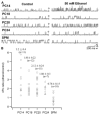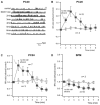Acute alcohol tolerance is intrinsic to the BKCa protein, but is modulated by the lipid environment
- PMID: 18084004
- PMCID: PMC4127471
- DOI: 10.1074/jbc.M708214200
Acute alcohol tolerance is intrinsic to the BKCa protein, but is modulated by the lipid environment
Abstract
Ethanol tolerance, in which exposure leads to reduced sensitivity, is an important component of alcohol abuse and addiction. The molecular mechanisms underlying this process remain poorly understood. The BKCa channel plays a central role in the behavioral response to ethanol in Caenorhabditis elegans (Davies, A. G., Pierce-Shimomura, J. T., Kim, H., VanHoven, M. K., Thiele, T. R., Bonci, A., Bargmann, C. I., and McIntire, S. L. (2003) Cell 115, 655-666) and Drosophila (Cowmeadow, R. B., Krishnan, H. R., and Atkinson, N. S. (2005) Alcohol. Clin. Exp. Res. 29, 1777-1786) . In neurons, ethanol tolerance in BKCa channels has two components: a reduced number of membrane channels and decreased potentiation of the remaining channels (Pietrzykowski, A. Z., Martin, G. E., Puig, S. I., Knott, T. K., Lemos, J. R., and Treistman, S. N. (2004) J. Neurosci. 24, 8322-8332) . Here, heterologous expression coupled with planar bilayer techniques examines two additional aspects of tolerance in human BKCa channels. 1) Is acute tolerance observed in a single channel protein complex within a lipid environment reduced to only two lipids? 2) Does lipid bilayer composition affect the appearance of acute tolerance? We found that tolerance was observable in BKCa channels in membrane patches pulled from HEK cells and when they are placed into reconstituted 1-palmitoyl-2-oleoyl-sn-glycero-3-phosphatidylethanolamine/1-palmitoyl-2-oleoyl-sn-glycero-3-phosphatidylserine membranes. Furthermore, altering bilayer thickness by incorporating the channel into lipid mixtures of 1,2-dioleoyl-3-phosphatidylethanolamine with phosphatidylcholines of increasing chain length, or with sphingomyelin, strongly affected the sensitivity of the channel, as well as the time course of the acute response. Ethanol sensitivity changed from a strong potentiation in thin bilayers to inhibition in thick sphingomyelin/1,2-dioleoyl-3-phosphatidylethanolamine bilayers. Thus, tolerance can be an intrinsic property of the channel protein-lipid complex, and bilayer thickness plays an important role in shaping the pattern of response to ethanol. As a consequence of these findings the protein-lipid complex should be treated as a unit when studying ethanol action.
Figures






Similar articles
-
Alcohol tolerance in large-conductance, calcium-activated potassium channels of CNS terminals is intrinsic and includes two components: decreased ethanol potentiation and decreased channel density.J Neurosci. 2004 Sep 22;24(38):8322-32. doi: 10.1523/JNEUROSCI.1536-04.2004. J Neurosci. 2004. PMID: 15385615 Free PMC article.
-
Cholesterol antagonizes ethanol potentiation of human brain BKCa channels reconstituted into phospholipid bilayers.Mol Pharmacol. 2003 Aug;64(2):365-72. doi: 10.1124/mol.64.2.365. Mol Pharmacol. 2003. PMID: 12869641
-
BK channel subunit composition modulates molecular tolerance to ethanol.Alcohol Clin Exp Res. 2008 Jul;32(7):1207-16. doi: 10.1111/j.1530-0277.2008.00704.x. Alcohol Clin Exp Res. 2008. PMID: 18537940
-
Ethanol interactions with calcium-dependent potassium channels.Alcohol Clin Exp Res. 2007 Oct;31(10):1625-32. doi: 10.1111/j.1530-0277.2007.00469.x. Alcohol Clin Exp Res. 2007. PMID: 17850640 Review.
-
Modulation of BK Channels by Ethanol.Int Rev Neurobiol. 2016;128:239-79. doi: 10.1016/bs.irn.2016.03.019. Epub 2016 May 12. Int Rev Neurobiol. 2016. PMID: 27238266 Free PMC article. Review.
Cited by
-
The relationship between duration of initial alcohol exposure and persistence of molecular tolerance is markedly nonlinear.J Neurosci. 2011 Feb 16;31(7):2436-46. doi: 10.1523/JNEUROSCI.5429-10.2011. J Neurosci. 2011. PMID: 21325511 Free PMC article.
-
The molecular basis of tolerance.Alcohol Res Health. 2008;31(4):298-309. Alcohol Res Health. 2008. PMID: 23584007 Free PMC article. Review.
-
Alcohol's effects on brain and behavior.Alcohol Res Health. 2010;33(1-2):127-43. Alcohol Res Health. 2010. PMID: 23579943 Free PMC article. Review.
-
Putative calcium-binding domains of the Caenorhabditis elegans BK channel are dispensable for intoxication and ethanol activation.Genes Brain Behav. 2015 Jul;14(6):454-65. doi: 10.1111/gbb.12229. Genes Brain Behav. 2015. PMID: 26113050 Free PMC article.
-
The role of the BK channel in ethanol response behaviors: evidence from model organism and human studies.Front Physiol. 2014 Sep 9;5:346. doi: 10.3389/fphys.2014.00346. eCollection 2014. Front Physiol. 2014. PMID: 25249984 Free PMC article. Review.
References
-
- Davies AG, Pierce-Shimomura JT, Kim H, VanHoven MK, Thiele TR, Bonci A, Bargmann CI, McIntire SL. Cell. 2003;115:655–666. - PubMed
-
- Cowmeadow RB, Krishnan HR, Atkinson NS. Alcohol Clin Exp Res. 2005;29:1777–1786. - PubMed
-
- Peoples RW, Li C, Weight FF. Annu Rev Pharmacol Toxicol. 1996;36:185–201. - PubMed
Publication types
MeSH terms
Substances
Grants and funding
LinkOut - more resources
Full Text Sources
Research Materials
Miscellaneous

